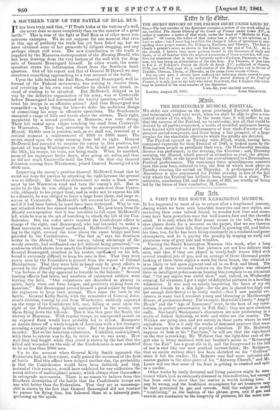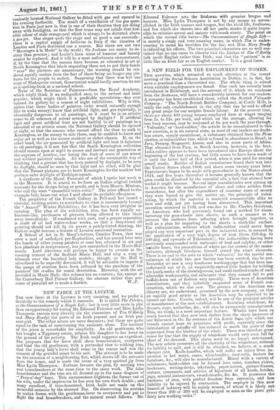ftwe 51..rto.
A VISIT TO THE SOUTH KENSINGTON MUSEUM..
IT has happened to most of us to return after a lengthened journey, during which we have seen beautiful countries and rare sights, and revisiting then some valued friend, to wonder how time and mono- tony have been powerless over the well-known face and the cheerful mind. It is only when the first pause comes in the talk, when the eyes glance down for a moment on the carpet, that we see thereon crows'-feet about their lids, that our friend is growing old, and before his time, too, for he has been living constantly in a confined and gassy atmosphere, and he is paying the penalty by reaping an early and plenteous crop of grey hair and wrinkles.
Visiting the South Kensington Museum this week, after a long absence, it occurred to me that pictures are not less delicate than ' men, and that if they are placed in newly-built rooms filled with several hundred jets of gas, and an average of three thousand people looking at them three nights a week for three hours, the vitiated air is as likely to tell upon pigment and oil as on flesh and blood. The average of three thousand visitors on the free nights was obtained from an intelligent policeman on hearing him complain to an attendant that "the pay nights was awful slow," and, indeed, on Wednesday evening, for sixpence, I got a sight of delightful pictures in a howling wilderness. It was only on calmly inspecting the faces of my old pictorial friends by a dim light—for the gas is placed too high and not enough distributed to be really useful—that I saw painful evi- dences, in many that I recollect young and blooming in Marlborou House, of premature decay. For example, Reynolds's lovely "An_ Heads" and the "Age of Innocence" were, to the best of my recol- lection, in perfect preservation in Pall Mall ; they are now cracking sadly. Stothard's Shakspeare's characters are now performing in a storm of forked lightning, so wide and white are the cracks. The Wilkie& are going also, and not merely in those parts where he used
asphaltum. or is it only the works of deceased painters that seem to be martyrs in the cause of popular education. If Mr. Malready happens to look at his "Fair-time," he will see that the sio.n-board on the tree is cracking; Mr. Webster that the light-blue sash of the girl who is being deafened with her brother's music in "Returning from the Fair" has a great slit in it, and the foreground to the left of her is rent like our now parched harvest-fields; Mr. Redgram that an entire railway chart has been sketched on his "Gulliver since it left his studio ; Mr. Roberts may find some splendid old- master gashes in the altar-piece of his "Antwerp Church," and Mr. Lance will see that some of his fruit is getting as crooked and split as a medlar.
Other works by lately deceased and living painters might be men- tioned which look as ominously diseased in this collection, but enough has been said to show that the matter is worth looking into. I may be wrong, and the healthiest atmosphere for art treasures may be that generated by gas and crowds. Still the subject is worth "ventilating," as the fashion of the phrase goes, and if gas and crowds are conducive to the longevity of pictures, let the more con- veniently located National Gallery be fitted with gas and opened in the evening forthwith. The result of a ventilation of the gas pes:. tion in Pans just now is, that in one of their theatres they are doing away with footlights, so that the first tenor may not inhale that hor- rible odour of stale orange-peel which is always to be detected above a gas-jet. One singer quits the stage and as good a one succeeds : there is a capital supply of balkrine in Italy if the theatres of London and Paris destroyed one a season. But there are not two "Marriages b. la Mode" in the world ; Sir Joshults are easier to de- stroy than procure; and Leslie's keen sense of humour and beauty cannot he replaced. And it will be a most unfortunate circumstance, if, by the time that the masses have become so educated in art at South Kensington that labels requesting them not to put their hands "near" the pictures are unnecessary, the warning should be ren- dered equally useless from the fact of there being no longer any pic- tures for the people to molest. Supposing that there was but one copy of Shakspeare extant, Government would hardly sanction its use as a spelling-book at a national school. None of the Societies of Painters—from the Royal Academy, which might think it an undignified step, to the newest and least popular, which might think it a profitable speculation—has ever opened its gallery for a season of night exhibitions. Why is this, unless that these bodies of painters (who would naturally enough like to make money) know that artificial light, and gas especially, is chemically dangerous to oil paintings, as it must be in an artistic sense to all schemes of colour arranged by daylight ? If artificial light and great artificial heat are not hurtful to oil paintings in a chemical or an artistic sense, the National Gallery should be opened at night, so that the masses who cannot afford the time to walk to Kensington, or the money to ride there, may be enabled to know and enjoy art as well as the nearer resident or richer classes. If, on the other hand, the air generated by artificial light and heat is injurious to oil paintings, it is not fair that the South Kensington collection should remain open at night to amuse and instruct one generation at the expense of another, one losing the fruit of some of our wisest and wittiest painters' minds. All who are of the unscientific way of thinking that a picture that has been painted by daylight, to be seen by daylight, should be seen by that light and no other, will be glad that the Turner pictures are to leave Kensington for the murkier but perhaps safer daylight of Trafalgar-square.
A duplicate of the Mural Fountain of which I spoke last week is in the Museum. It is stated to be from an Italian original (which accounts for the design being so good), and is from Messrs. Minfons, u-ho call the ware "enamelled terra cotta." The price affixed to the example fully bears out what I said about its probable cfieapness.
The proprietor of the French Gallery in Pall-mall has issued a circular, inviting artists to contribute to what is inaccurately termed the "Annual" Winter Exhibition; for it has been very irregular in opening. The plan of the exhibition, also, has been equally un- business-like, purchasers of pictures being allowed to take them away immediately. If conducted with care, and a proper separation is made of oil and water-colour works, so that a deep-toned oil painting should not kill by its power a pearly-tinted drawing, the Gallery might become a feature of London autumnal recreation. A School of Art in St. Mary's-terrace, Camden Town, that was once a nest of unfledged pre-Raphaelites, and has passed later into the hands of other young painters at once less educated in art and less pharisaic in temperament, has just succumbed to the Music-Hall mania. Lord Aberdeen will perhaps be happy to preside at the opening concert of the Bedford Music Hall, and sing a song of triumph over the banished lady models ; though, as the Hall is advertised to be superbly decorated, it will be advisable to inquire if the pangs of eviction have been softened by the purchase of the painters' life studies for mural decoration. However, with the art provided in Music Halls this column has no concern; for, except at the Canterbury Hall Picture Gallery, the absence rather than pre- sence of pictorial art is made a feature.































 Previous page
Previous page